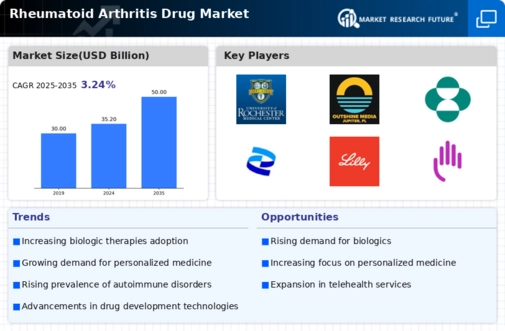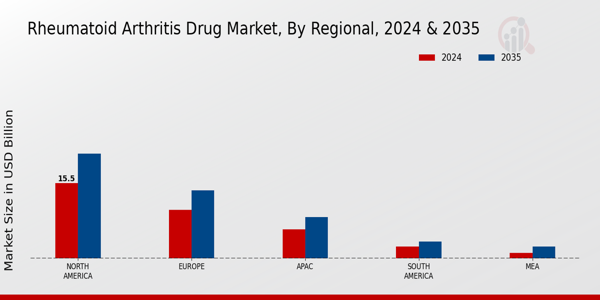Market Growth Projections
Advancements in Biologic Therapies
Innovations in biologic therapies are significantly influencing the Global Rheumatoid Arthritis Drug Market Industry. These advanced treatments, which include monoclonal antibodies and fusion proteins, have transformed the management of rheumatoid arthritis, offering targeted mechanisms of action that improve patient outcomes. The introduction of new biologics is expected to enhance treatment efficacy and safety profiles, leading to increased adoption among healthcare providers. As a result, the market is poised for growth, with projections indicating a rise to 50 USD Billion by 2035. This advancement underscores the importance of ongoing research and development in the field.
Emerging Markets and Economic Growth
Emerging markets are playing a pivotal role in the expansion of the Global Rheumatoid Arthritis Drug Market Industry. Economic growth in regions such as Asia-Pacific and Latin America is leading to increased healthcare spending and improved access to medications. As disposable incomes rise, patients are more likely to seek treatment for chronic conditions like rheumatoid arthritis. Pharmaceutical companies are recognizing this potential and are focusing on these markets for future growth opportunities. This shift is expected to contribute to the overall market growth, with a compound annual growth rate of 3.24% anticipated from 2025 to 2035.
Rising Awareness and Diagnosis Rates
The Global Rheumatoid Arthritis Drug Market Industry benefits from heightened awareness and improved diagnostic capabilities. Increased public knowledge about the symptoms and consequences of rheumatoid arthritis has led to earlier diagnosis and treatment initiation. Healthcare professionals are also better equipped to identify the disease due to advancements in diagnostic tools and criteria. This trend is crucial as timely intervention can significantly alter disease progression and improve quality of life for patients. Consequently, the market is expected to grow steadily, with a projected compound annual growth rate of 3.24% from 2025 to 2035, reflecting the ongoing commitment to enhancing patient care.
Increasing Prevalence of Rheumatoid Arthritis
The Global Rheumatoid Arthritis Drug Market Industry is experiencing growth driven by the rising prevalence of rheumatoid arthritis worldwide. As populations age, the incidence of this autoimmune disorder is expected to increase, with estimates suggesting that approximately 1.3 million adults in the United States alone are affected. This trend is mirrored globally, as healthcare systems adapt to manage chronic conditions. The growing patient population necessitates the development and availability of effective treatment options, contributing to the market's expansion. By 2024, the market is projected to reach 35.2 USD Billion, indicating a robust demand for innovative therapies.
Growing Investment in Healthcare Infrastructure
Investment in healthcare infrastructure is a key driver for the Global Rheumatoid Arthritis Drug Market Industry. Governments and private entities are increasingly allocating resources to improve healthcare facilities and access to medications. This investment is particularly vital in developing regions, where access to rheumatology specialists and treatment options may be limited. Enhanced infrastructure facilitates better patient management and adherence to treatment regimens, ultimately driving demand for rheumatoid arthritis drugs. As healthcare systems evolve, the market is likely to experience sustained growth, aligning with the projected increase in market value to 50 USD Billion by 2035.

























